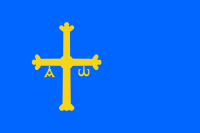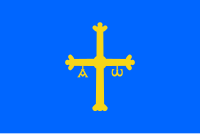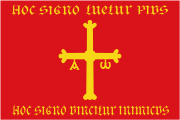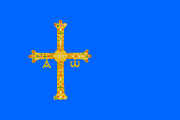 | |
| Asturina, Azuleste[1] | |
| Use | National flag and ensign |
|---|---|
| Proportion | 2:3 |
| Adopted | December 19, 1990 (current version, as established in Law 4/1990) |
| Design | The Victory Cross in yellow, off-centred toward the hoist, over blue. |
 | |
| Use | Civil flag and ensign |
| Proportion | 2:3 |
| Adopted | 28 May 1785 (original naval ensign version) 5 October 1981 (current version, changed coat of arms) |
| Design | The Victory Cross in yellow, centred, over blue. |

The flag of Asturias shows the "Cruz de la Victoria" (Victory Cross) in yellow (PMS 109) over blue (PMS 829).
Design[edit]
According to the tradition, the Victory Cross was carried by Pelagius, first King of Asturias, in the decisive Battle of Covadonga against the Moors in 722. This battle, fought in the mountains of Asturias, was hailed by 19th and 20th century historiography as the start of the Reconquista, the Christian re-conquest of the Iberian peninsula from the Moorish domination. However, there is not any historical evidence about the use of this cross.
In 908 the Asturian King Alfonso III the Great ordered that the original wooden cross, made of oak, be clad in gold and precious stones. Currently, it is kept in the Holy Chamber of the Oviedo Cathedral.
The Greek letters Alpha and Omega hang from its horizontal axis. This is a direct reference to the Book of Revelation (verses 1:8, 21:6, and 22:13)., I am the Alpha and the Omega, the beginning and the end, says the Lord God, who is, and who was, and who is to come, the Almighty.
Color specifications[edit]
| Scheme | Blue | Yellow |
|---|---|---|
| Pantone | 829 | 109 |
| RGB | 0-102-255 | 247-212-23 |
| HTML | #0066FF | #F7D417 |
History[edit]
The banners that might represent the early medieval Kingdom of Asturias are unknown, although a white ensign with a red border and a cross of the same color has been attributed as the royal flag of Ramiro I, as can be seen in tomb A of the Cathedral in Santiago of Compostela. Gaspar Melchor de Jovellanos, an Asturian intellectual of the Enlightenment, led a note with his findings on the symbols of the Kingdom of Asturias, based on the older description of Lazaro Diaz del Valle an author of 17th Century. According to this instruction, the Victory Cross was gold on a scarlet background, i.e. the early colors of the church.
The origin of the flag of Asturias is in 1808, during the Peninsular War. As there was not any Spanish official flag yet, Asturians created the current flag, without any separatist intention in the war against the Napoleon's empire.[2] In its first version, it included the motto Asturias jamás vencida (Asturias never defeated).
Variant Asturina[edit]
The flag of Asturias with red star, also called plain Asturina, is a version of the flag of Asturias with a five-pointed red star on top of the pole and a cross in the middle, without the letters alpha and omega. This flag is associated with pro-independence, socialist and communists groups in Asturias. This variant comes from the cultural collective Conceyu Bable who developed it in the mid-1970s. In other Spanish regions also have variants of their flags with red stars, for example, in Galicia there is Estreleira.
See also[edit]
References[edit]
- ^ Miguel Ramos Corrada (2002). Historia de la Lliteratura Asturiana (in Asturian). ISBN 9788481683356. Retrieved 8 September 2016.
- ^ "Los tres momentos históricos en los que Asturias pudo ser independiente" (in Spanish). La Voz de Asturias. 8 September 2016. Retrieved 8 September 2016.



